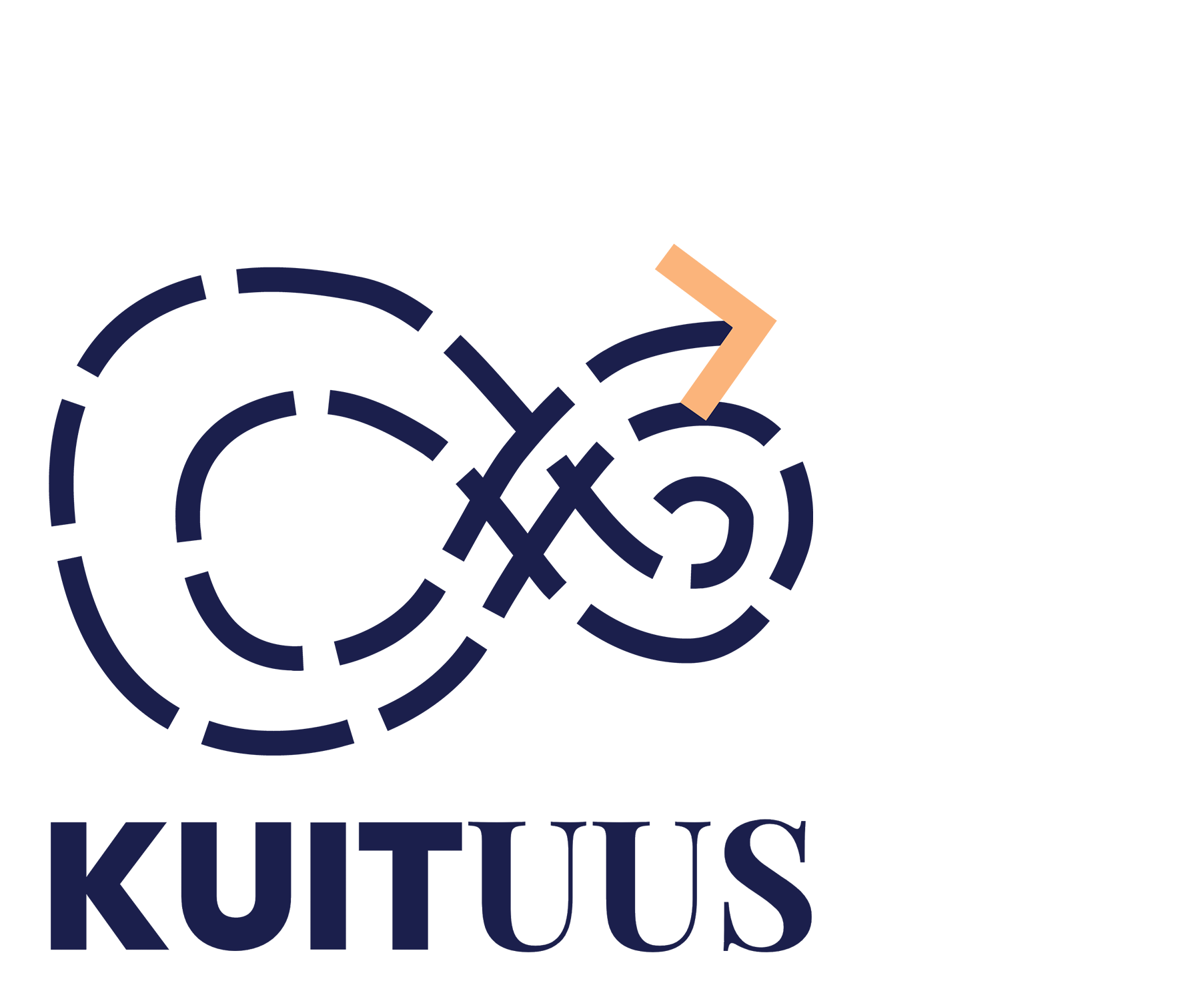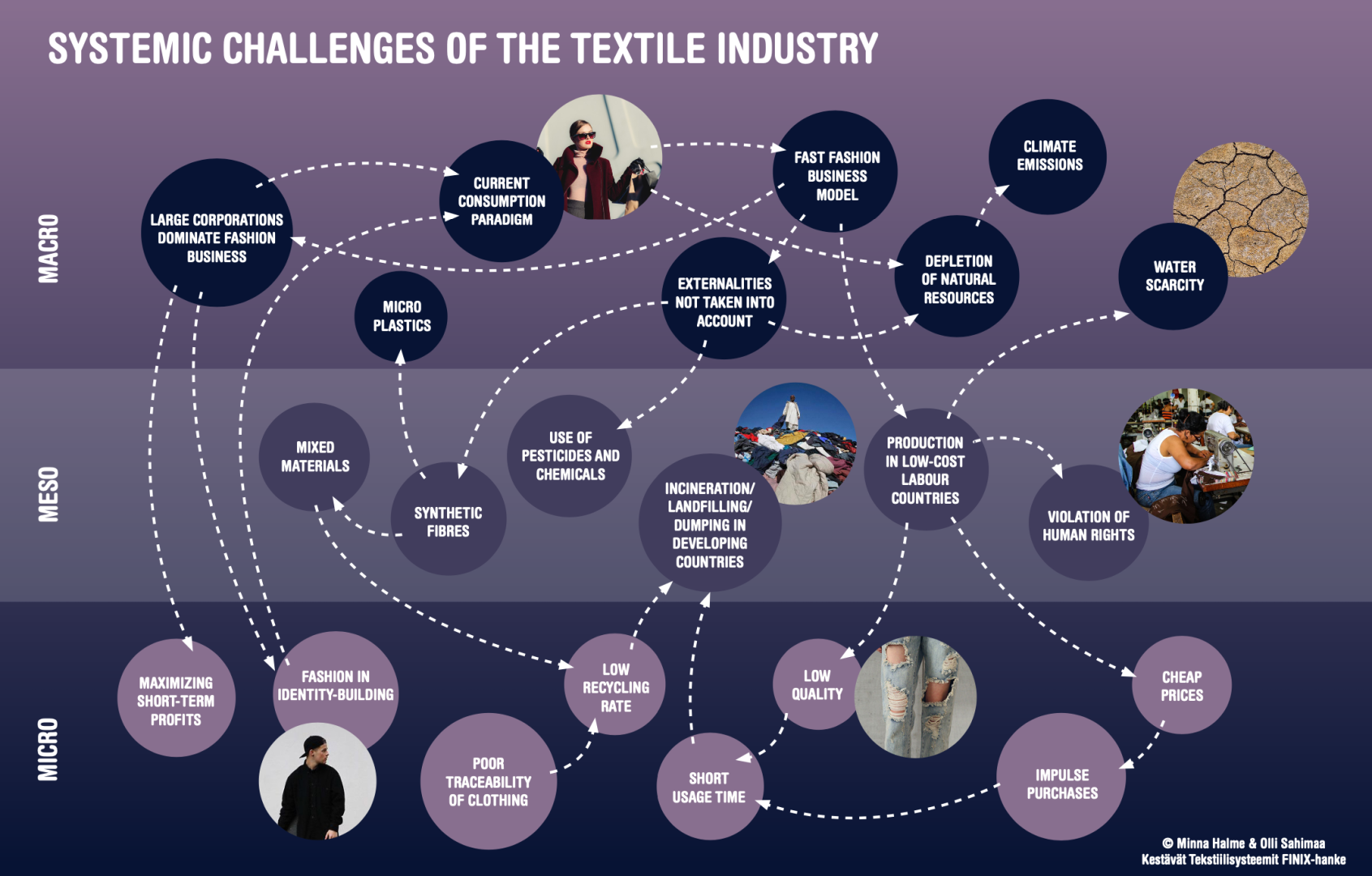1: WHY?
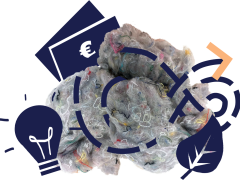
1: WHY?
Why should my company get inspired by recycled textile fibre as a raw material?
In Finland, nearly 90 000 tonnes of end-of-life textiles are created every year. In order to make use of this valuable raw material, it is necessary to find both utilisers and ways to use it in accordance with the circular economy principles in order to reduce the need for virgin materials.
Recycled textile fibre is a versatile raw material, and its use instead of virgin materials is driven by regulation, sustainability requirements and business potential. In the first chapter of the Kuituus online book, we go through some of the main reasons why your company should be interested in utilising recycled textile fibre as a raw material.
References
SYKE (17.6.2021) Suomen tekstiilivirtaselvitys: Tekstiilien kulutus Suomessa tasaista, poistotekstiilien määrät kasvussa
Contents
Intro: What is all this about?
- What is recycled textile fibre?
- Why should you be interested in recycled textile fibre – and why now?
1.1 Opportunities for companies
- Sustainable business from recycled textile fibres
- The growing market potential of textile recycling
- Locally produced recycled textile fibre enables responding to a global resource scarcity
1.2 Sustainability demands are increasing
- Consumers’ appreciation towards recycled materials and responsible purchases is on the rise
- EU-level requirements for sustainable business and products are increasing
- Finland invests in the circular economy and aims to be a frontrunner
1.3 Recycled textile fibres in response to global sustainability challenges
- The challenging operating environment of the textile industry
- Sustainability benefits of recycled fibre
INTRO
What is all this about?
Sorted, clean end-of-life textile is waiting for the treatment into new fibre and products.
What is recycled textile fibre?
Recycled textile fibre refers to a fibre that has been separated from used textiles, such as used clothes collected from households. In a way, the textile is returned back into a fibre that it was originally made of. Fibres can be separated either mechanically or chemically. Recycled textile fibre can be used for various purposes, similar to fibres made of virgin material. In addition to clothes and textile industry, it is suitable to use in nonwovens, insulation, and composites. You will learn more about the properties and uses of recycled textile fibre in the Chapter 2 of this online book!
Why should you be interested in recycled textile fibre – and why now?
An important change for the better utilisation of recycled textile fibre is the upcoming EU waste directive that comes into effect in 2025. This directive states that each EU member state is obligated to organise the separate collection for household textile waste from 2025 onwards. In Finland, the separate collection is to begin by the year 2023. This means that from the year 2023 onwards, household textiles that are removed from use should be delivered to regional collection bins. Through these, the textiles will continue their journey towards the textile recycling plant in the Turku region. The pilot plant is currently located in Paimio.
This recycling plant is owned by Rester Ltd. and it is the first industrial scale recycling plant for end-of-life textiles in the Nordic countries. The plant started operating in 2021. The plant produces recycled textile fibre which is suitable for manufacturing various industrial raw materials – it can be made into yarn and fabric for the clothing industry, insulation materials for the construction or shipbuilding industries, or even into composites for the furniture industry. Lounais-Suomen Jätehuolto (Southwest Finland Waste Management Ltd., LSJH for short) operates in the same property that is owned by Rester Ltd. Both have their own recycling plants: LSJH handles the recycling of post-consumer textiles, whereas Rester takes care of end-of-life textiles from companies.
Thanks to the new recycling plant, a significant amount of recycled textile fibre will soon be available for company use. In total, the plant’s capacity is 12 000 tonnes of end-of-life textiles, covering about 10 percent of Finland’s textile waste. LSJH is also preparing a full-scale recycling plant with the capacity to handle the end-of-life textiles from all Finnish households to be opened at Turku’s Topinpuisto area in 2023.
The purpose of this online book is to share information about recycled textile fibre and its potential for various uses. The first chapter of the book covers why recycled textile fibre is worth your interest!
References:
Kuituus podcast, episode 3
Researcher Marja Rissanen, Aalto University
European Parliament (29.12.2020) The impact of textile production and waste on the environment (infographic)
Lounais-Suomen Jätehuolto Oy (18.8.2020) Nordic countries’ first large-scale end-of-life textile refinement plant to open in Paimio in 2021
Uusiouutiset (21.5.2021) Poistotekstiili kiertoon Suomessa
1.1
Opportunities for companies
Sustainable business from recycled textile fibres
According to Satumaija Levón, the sustainability and circular economy expert of Finnish Textile & Fashion (STJM for short), there is an enormous global business potential in the circular economy of textiles. The circularity of textiles is a megatrend, and Levón sees moving towards more sustainable solutions as a vital condition for keeping up with the competition in the future. Nevertheless, Finnish companies have every chance of becoming international forerunners in this sector.
Recycling end-of-life textiles into new fibre gives companies an opportunity to have sustainable business models, carbon neutrality and to minimise expenses. It enables companies to operate in a way that is required by both consumers and investors. In addition, it provides opportunities for companies to respond to the growing costs of material and logistics with the means of a local, circular economy. Some companies have already set targets for increasing their use of recycled materials. Therefore, the transition to recycled materials in the manufacturing industry enables also responding to the sustainability targets and criteria of their client companies.
Utilising recycled materials is a way for standing out from competition but also for making profitable business. For example, both the Finnish Sinituote Ltd. and Pure Waste Textiles Ltd. report that the demand for products made of recycled materials has increased, especially within the past few years. This has enabled them to increase sales. In Finland alone, there are multiple examples of companies that are successfully utilising recycled materials in their products. Check out the inspiring examples from our website’s Examples -section or from Sitra’s list of the Most interesting companies in the circular economy in Finland 2.1. It is also worth getting to know pioneering companies outside Finland – Business Europe and EURATEX have compiled a list of European circular economy companies in the textile sector.
References
Business Finland, Satumaija Levón. (11.12.2018) Vast global business potential in the circular textile economy.
Finnish Textile & Fashion. Circular Economy in the Finnish Textile Business.
LAB-ammattikorkeakoulu (16.12.2020) Vaateteollisuuden kasvihuonepäästöistä yli 40 prosenttia olisi ratkaistavissa kuluttajien valinnoilla
Suomen Tekstiili & Muoti ry (16.9.2021) Tekstiili- ja muotialan näkymät optimistisia – raaka-aine- ja logistiikkakustannusten nousu kuitenkin uhkaa koronan jälkeistä kasvua.
Kuituus podcast, episode 6
Kuituus podcast, episode 5
Kuituus podcast, episode 1
The growing market potential of textile recycling
According to VTT’s preliminary estimate, the market potential of mechanical recycling alone accounts for 60-120 million euros. According to the estimate of Finnish Textile & Fashion, the employment impact of collection, refining and handling of Finnish end-of-life textiles could amount to 1 400 jobs. However, there is potential for business also outside of Finland, especially in the regions near Stockholm and St. Petersburg. Moreover, the market potential of textile recycling increases once circular business operations and other recycling technologies are taken into consideration. In addition to mechanical recycling, the reuse of textiles, chemical recycling and energy recovery of textiles are currently under research and development in Finland. There is an estimated market potential for all of these applications, too.
The growing market potential for textile recycling is influenced by a global change in the textile industry. Ali Harlin, Research Professor at VTT, states that all big producers in the international fast fashion markets have promised their owners to change their operations in order to be accepted and capable to operate even in the following decades. In total, a sustainable textile industry could enable investments worth of 1,2 billion and an employment impact of approximately 17 000 people in Finland. It is hoped that the textile industry could become the new export product of Finland and that Finland would become one of the most significant recyclers in Northern Europe.
Locally produced recycled textile fibre enables responding to a global resource scarcity
The market for textiles is expected to grow by 40 % in the next decade. However, the existing resources will not be sufficient to meet the continuously growing demand of the textile industry. In the future, this could lead to high prices and difficulties in the supply of cotton. It has even been estimated that due to growing production, the world may run out of cotton entirely – of which there is currently already a shortage. Therefore, utilising virgin materials may not be an option in the future. Also, fibres that are made of nonrenewable resources, such as polyester that is made of petroleum, are worth replacing with recycled materials.
The end-of-life textile refinement plant of Rester and Southwest Finland Waste Management provides companies with a large amount of versatile, recycled fibre. In total, the plant’s capacity is 12 000 tonnes of end-of-life textiles, covering about 10 percent of Finland’s textile waste. LSJH is also preparing a full-scale recycling plant with the capacity to handle the end-of-life textiles from all Finnish households to be opened at Turku’s Topinpuisto area in 2023.
References
Lounais-Suomen Jätehuolto Oy (18.8.2020) Nordic countries’ first large-scale end-of-life textile refinement plant to open in Paimio in 2021
Anniina Nurmi. Polyesteri.
LAB-ammattikorkeakoulu (16.12.2020) Vaateteollisuuden kasvihuonepäästöistä yli 40 prosenttia olisi ratkaistavissa kuluttajien valinnoilla
YLE (13.10.2017) Puuvilla loppuu – vaateteollisuuden on nyt pakko keksiä uusia vaihtoehtoja tilalle
VTT (4.8.2021) Efficient textile fibre recycling will soon begin – Finland is leading the way
1.2
Sustainability demands are increasing
Consumers’ appreciation towards recycled materials and responsible purchases is on the rise
The use of recycled materials is driven not only by the currently unsustainable use of resources in the textile industry but also by consumers’ demands for sustainability. The potential demand for even just recycled fashion and clothing is significant within the EU market. According to an estimate, over 37 % of the EU citizens are interested in sustainability themes and consider it in their clothing purchases.
Additionally, 75 % of Finns who answered VTT’s questionnaire stated significant or moderate interest in buying products made of recycled materials. The rate was even higher for young European respondents, of whom 91 % would be very or moderately interested in buying such products. According to VTT, sustainability is a growing trend and sustainability values are influencing also behaviour and purchasing decisions. The finding is supported by a Finnish company example – Sinituote, who visited in the 6th episode of the Kuituus podcast series. The company representative stated that consumers do favour environmentally friendly products as long as they also fulfil the consumer requirements for quality. Hence, the launch of their circular economy products did lead to a clear increase in the sales of Sinituote.
References
Kuituus podcast, episode 6
Kamppuri, Kallio, Mäkelä & Harlin (2021) Finland as a forerunner in sustainable and knowledge-based textile industry – Roadmap for 2035
CBI (30.8.2021) The European market potential for recycled fashion.
VTT (2021) Telaketju – Business from Circularity of Textiles
EU-level requirements for sustainable business and products are increasing
There is a pressure towards a more sustainable textile industry both on a national level as well as from the EU. For example, sanctions on the usage of virgin materials have been under consideration. Additionally, regulation could be directed especially towards public procurement by updating the rules of competitive tendering so that they should entail a specific portion of products made of recycled fibre where such are available. As regulation tightens, those ready for change are the ones that gain competitive advantage, too. In this paragraph, we’ve summarised some of the most central EU-level instruments for advancing the circular economy.
Waste directive
The EU waste directive mandates all EU member states to separately collect end-of-life textiles by the year 2025. In Finland, this is to begin already by the year 2023. Early adoption of the directive is an advantage for Finnish companies – it enables trying out new materials, such as recycled fibre from end-of-life textiles in a large scale and before others.
Green Deal
Currently, also the EU Green Deal is ongoing. The goals of the programme are to enable not only a resource efficient and competitive economy but also the first climate neutral region by the year 2050. As a central part of the Green Deal programme, the EU Commission published a new circular economy action plan in March 2021. The purpose of the circular economy action plan is to ensure that mainly products that are durable, repairable, reusable and recyclable will enter the markets. Multiple action points, such as sustainable products initiative and the EU strategy for sustainable textiles, are still to be published for the action plan during the year 2021.
Sustainable products initiative
The goal of the sustainable products initiative is to advance circular design, repairability and the use of recycled materials in products. It also seeks to restrain the planned obsolescence of devices.
Strategy for sustainable textiles
The EU strategy for sustainable textiles aims for a competitive textile industry, in which the principles of circular economy are taken into consideration throughout the entire value chain – in manufacturing, products themselves, consumption as well as in waste management and utilisation of recycled materials.
Read more about the EU’s circular economy actions:
- The European Parliament – How the EU wants to achieve a circular economy by 2050
References
European Parliament (10.2.2021) How the EU wants to achieve a circular economy by 2050
European Commission, Circular economy action plan.
European Commission, Sustainable products initiative.
European Commission, EU strategy for sustainable textiles.
YLE (24.6.2021) Suomen tekstiilijätteestä vain noin prosentti päätyy kierrätykseen – Paimion pilottiasema muuttaa vanhan paidan uudeksi kankaaksi
Uusiouutiset (03/2020) Oikeus korjata!
Finland invests in the circular economy and aims to be a frontrunner
In addition to the EU-level regulation, instruments and incentives towards a circular economy are expected within Finland, too. Prime Minister Sanna Marin’s administration has set a target for strengthening Finland’s role as a frontrunner in the circular economy. As a part of the implementation of this target, a strategic advancement programme for a circular economy has been compiled for Finland. The programme outlines the targets and necessary steps for Finland to remain a frontrunner in the circular economy. The goal is to turn the circular economy into a new foundation for the economy by the year 2035. Sustainable products and services, sustainable use of natural resources and circular use of materials are few of the central themes of the programme.
In order to enable a circular transition, both legislative and economic incentives are required, the report finds. In addition to national regulation and EU level influence, a circular economy should be advanced through voluntary instruments and by directing public procurement towards sustainability. Suggested economic incentives include setting a price to negative externalities (such as emissions), and taxation that supports the circular economy. Furthermore, an extended producer responsibility system and requirements for recycled materials are potential economic instruments. Read more about the programme here.
References
Ministry of the Environment. Strategic programme to promote a circular economy.
Valtioneuvosto (2021) Uusi suunta. Ehdotus kiertotalouden strategiseksi ohjelmaksi.
1.3
Recycled textile fibres in response to global sustainability challenges
The challenging operating environment of the textile industry
The textile and fashion industry is a cause for significant amounts of pollution, and according to some studies, produces more greenhouse gases than the flight and shipping industry combined. At the same time as the growing demand for fibres and textiles surpasses the supply of needed raw materials, an immense amount of usable resources are left unused. Globally, 92 million tonnes of textile waste is created – a majority of which ends up burned or in landfills.
In addition to greenhouse gases, the textile industry includes multiple other challenges, such as human rights violations in supply chains as well as unsustainable use of chemicals, pesticides and natural resources. For example, large cotton plantations decrease biodiversity and soil fertility, and require significant amounts of water and artificial fertilisers. Estimates state that producing a single t-shirt requires as much as 2 700 litres of water. The most used textile fibre, polyester, on the other hand, is made of nonrenewable petroleum and its production consumes a lot of energy and chemicals.
The global textile industry is a complex system, and tackling the various sustainability challenges of the industry requires actions throughout the value chain but also from consumers. Companies can, however, decrease the associated sustainability risks of the industry by utilising locally produced, recycled fibre. Learn more about the systemic challenges of the textile industry from the website of the FINIX-project.
References
Anniina Nurmi. Polyesteri.
Anniina Nurmi. Puuvilla.
Halme & Sahimaa. Systemic challenges of the textile industry.
LAB-ammattikorkeakoulu (16.12.2020) Vaateteollisuuden kasvihuonepäästöistä yli 40 prosenttia olisi ratkaistavissa kuluttajien valinnoilla
YLE (13.10.2017) Puuvilla loppuu – vaateteollisuuden on nyt pakko keksiä uusia vaihtoehtoja tilalle
Business Finland (15.2.2021) From New Materials to Anti-Virus Coating and an Upcoming Nordic Recycling Hub – Finland Offers New Solutions to Textile Industry Challenges
Sustainability benefits of recycled fibre
Utilising recycled textile fibre offers companies an opportunity to respond to global sustainability challenges and advance the company’s own sustainability goals. For example, 1 000 kg of recycled textile fibre produced by Rester, saves over 2 000 000 litres of water and over 5 000 kg CO2-eq. of carbon dioxide in comparison to a fibre made of virgin materials. Pure Waste tells that their product made of 100% of recycled materials consumes 99% less water and produces 50% less carbon dioxide emissions compared to a product made of virgin materials. In addition, mechanically recycled fibre does not need to be dyed as end-of-life textiles can be sorted based on colour. Therefore, also chemicals and energy are consumed less.
By taking circularity into consideration in one’s business operations, it is possible to support the UN’s Sustainable Development Goals. Below we have summarised the SDGs that companies are able to address by switching virgin materials to recycled textile fibre.
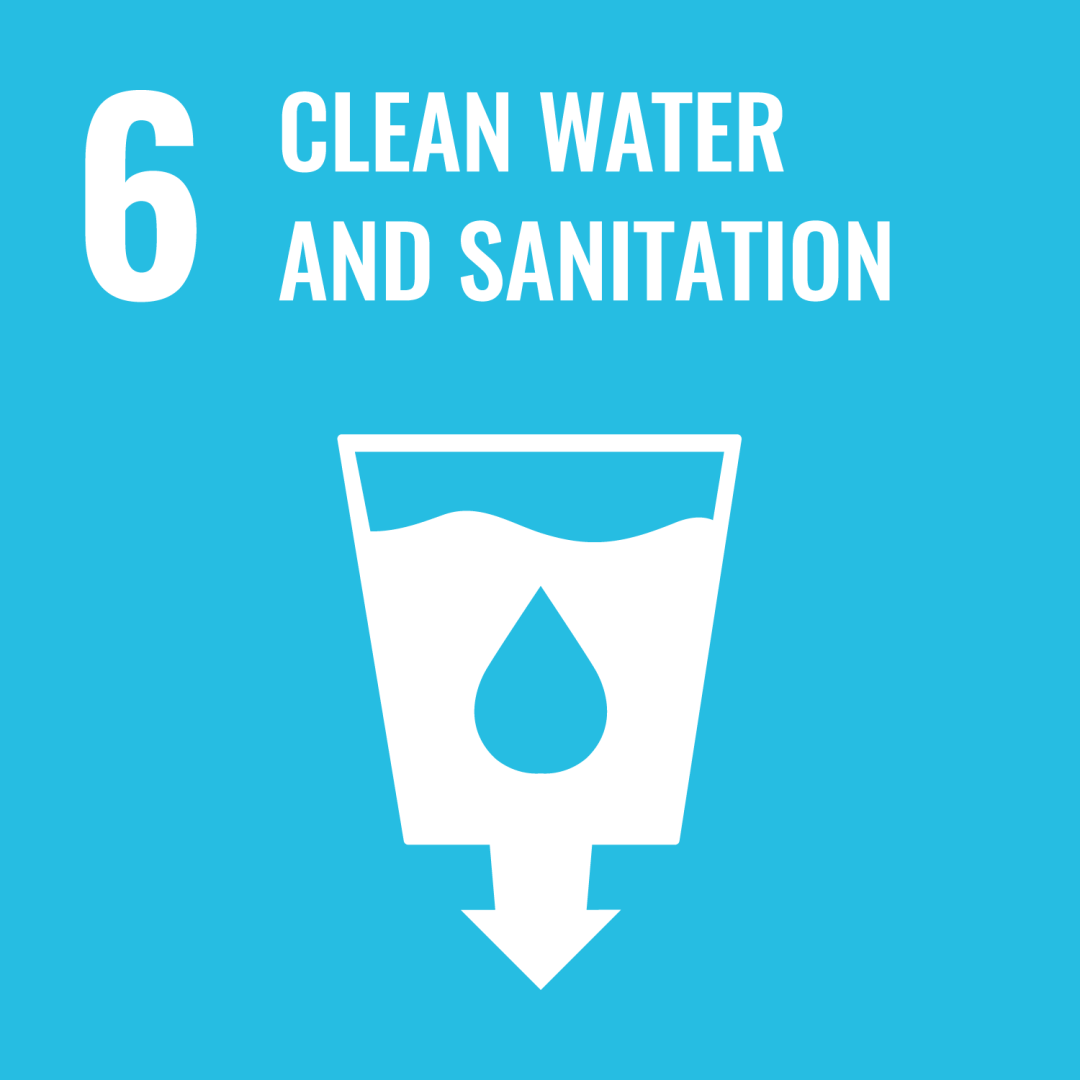
6. CLEAN WATER AND SANITATION
Goal: to ensure availability and sustainable management of water and sanitation for all
→ Recycled textile fibre consumes considerably less water compared to, e.g. water-intensive virgin cotton
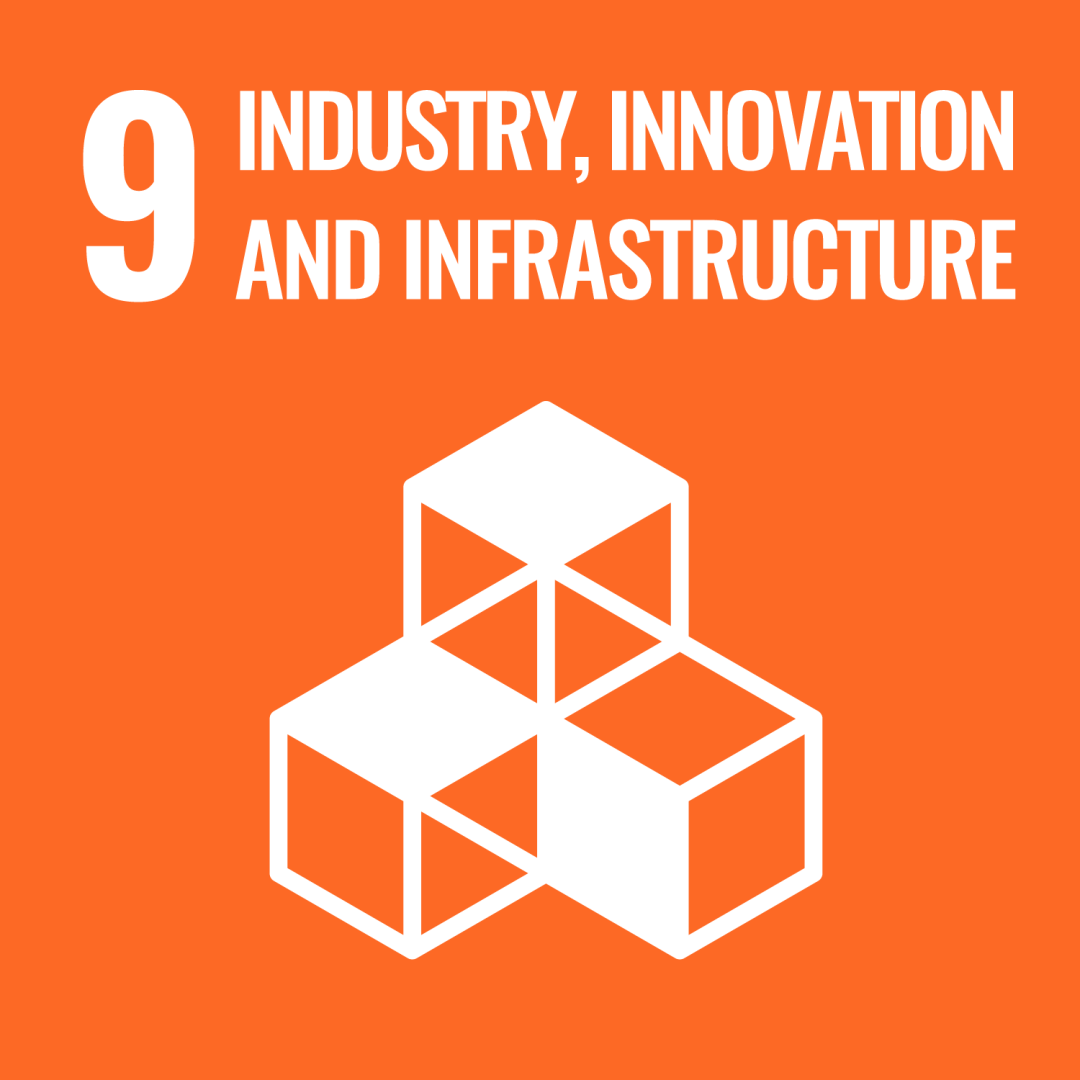
9. INDUSTRY, INNOVATION AND INFRASTRUCTURE
Goal: to build resilient infrastructure, promote inclusive and sustainable industrialisation and foster innovation
→ Recycled textile fibre offers various opportunities for use and it enables novel product and material innovations. Recycled textile fibre supports the transition towards a more sustainable textile industry

12. RESPONSIBLE CONSUMPTION AND PRODUCTION
Goal: to ensure sustainable consumption and production patterns
→ Recycled textile fibre supports circular business models, consumes less resources and produces less emissions when compared to virgin materials
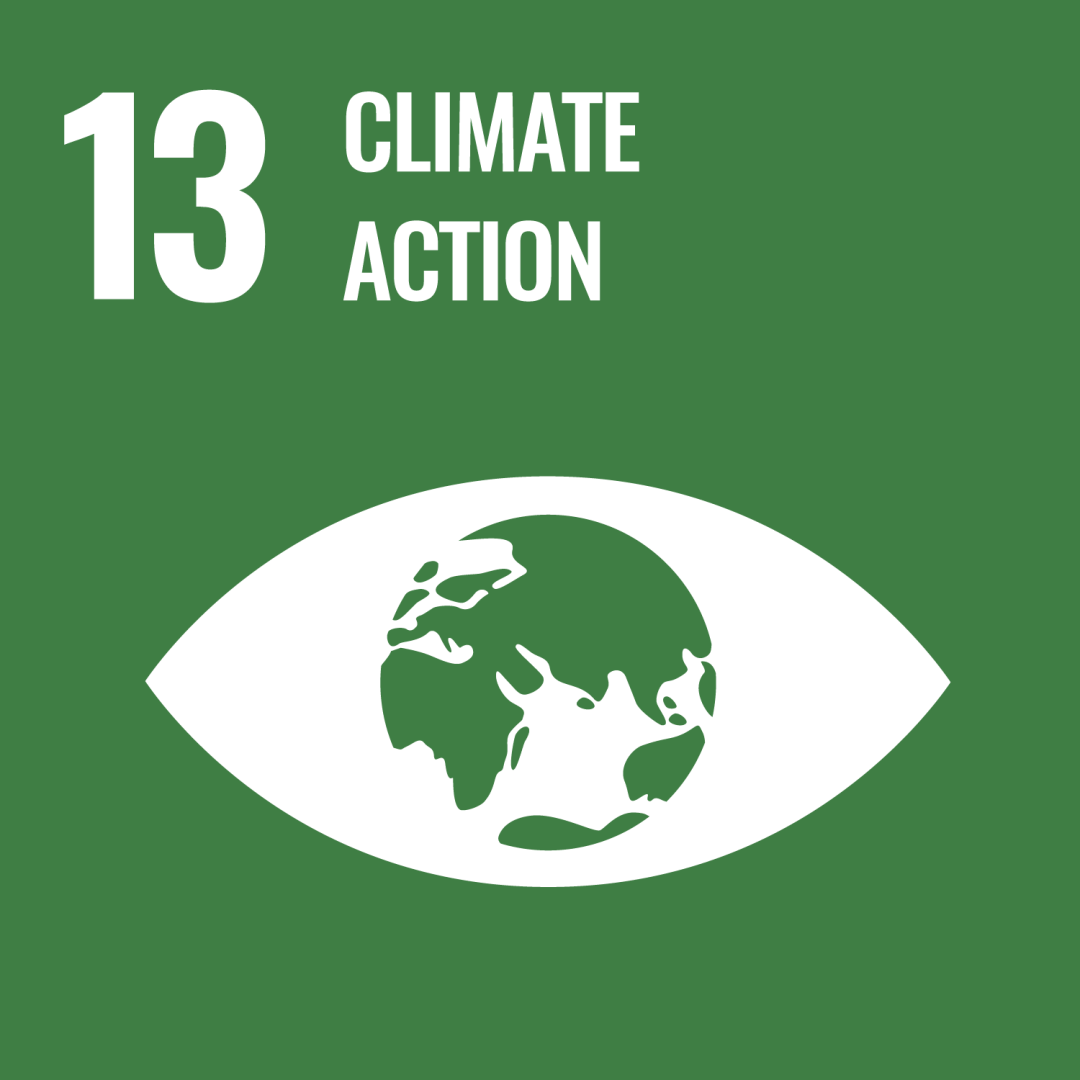
13. CLIMATE ACTION
Goal: to take urgent action to combat climate change and its impacts
→ Recycled textile fibre enables lowering production emissions and utilising valuable resources – textile waste discarded at landfills or by incineration account for increased greenhouse gas emissions
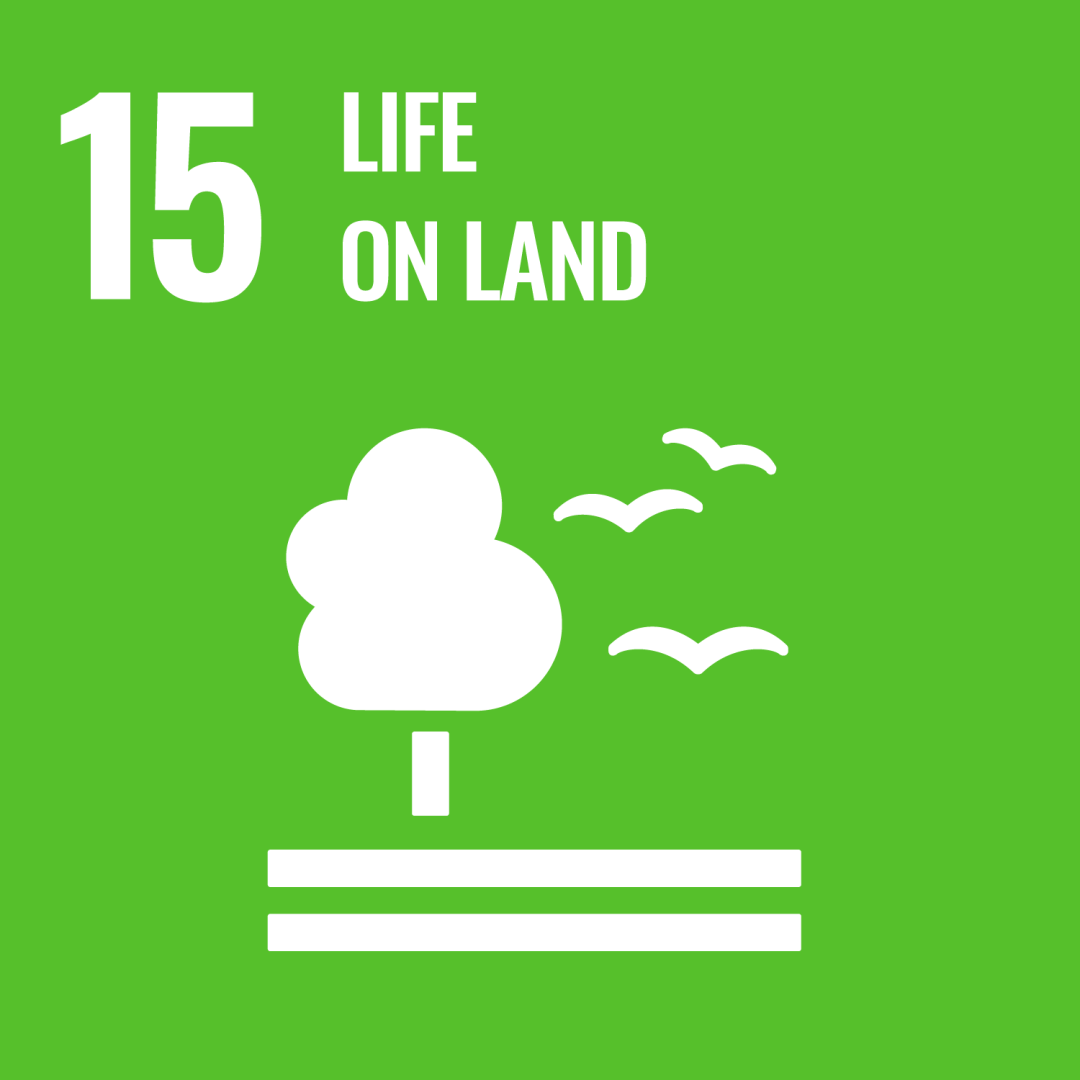
15. LIFE ON LAND
Goal: to protect, restore and promote sustainable use of terrestrial ecosystems
→ Recycled textile fibre reduces the need for virgin natural resources and chemicals, thus, leading to less stress towards land ecosystems
